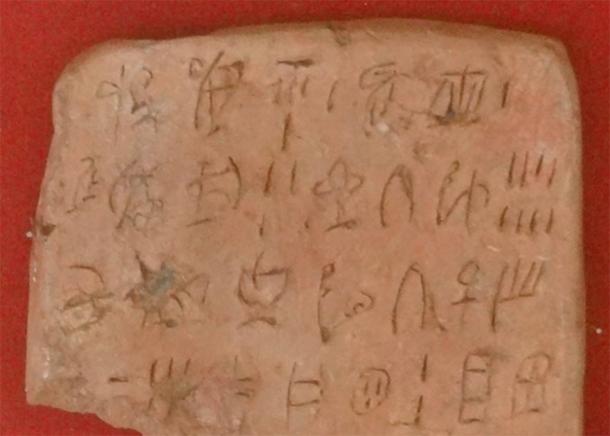In a major breakthrough, European researchers have used new methods to decipher the ancient Linear A script of Minoan civilization. The team’s research focused on Linear A fractional mathematical signs and symbols to help decipher the language. The Linear A script was mainly used for palace and religious writings by the Minoans. The problem is that, until now, not a single Linear A text has been deciphered! But recent scientific analysis, using fractional mathematics, offers a new way to interpret the enigmatic Linear A script.
Minoan Civilization Ruled The Aegean Area For 1500 Years!
Minoan civilization descended from Neolithic populations that migrated to Europe from the Middle East and Turkey. And 9,000 years ago, the Minoans became the first farmers on the island of Crete and other Aegean islands. The Minoans flourished in the Aegean area during the Bronze Age, between roughly 3000 BC to 1450 BC. The architectural wonders of Knossos (Crete) mark the peak of Minoan influence. By 1100 BC, the Minoans had faded away, “replaced” by the Bronze Age Mycenaean Greek culture .
The Victorian English archaeologist, Sir Arthur John Evans (1851-1941), discovered the palace of Knossos, and caves, rock shelters, houses, and settlements dating to 7000 BC. In the First Palace Period (around 2,000 BC) the urban area of Crete was home to around 18,000 people. However, at its peak, shortly after 1700 BC, the palace and surrounding city served a population that had swollen to over 100,000 people.

Just one of the fantastic scenes found at the palace of Knossos, Greece, where the Linear A script was once used and lost. (Iraklis Milas / Adobe Stock )
It was on the island of Crete, around 3,500 years ago, that the ancient Minoans developed a system of mathematical fractions that has never been decoded. Silvia Ferrara, a professor of the Department of Classical Philology and Italian Studies at the University of Bologna , has published a new study in the Journal of Archaeological Science that seems to, finally, offer a solution to the mystery of the Linear A script. The professor focused on recorded amounts, percentages, and totals related to trade in the Aegean area , which was dominated by the Minoans and their enigmatic script.
Mathematical Historians Defeated By Script Damage And Change
First discovered by Arthur Evans, the Linear A script belongs to a group of scripts that evolved independently of Egyptian and Mesopotamian writing systems during the Middle Minoan Period, specifically from 1625–1450 BC. The ancient Minoan writing system was composed of a set of signs that were also used to decorate jewelry and to mark funerary and votive offerings at religious sanctuaries. However, the primary use of the Linear A script was for accounting purposes at Minoan administrative centers.
The problem that has made Linear A fractions impossible to decipher is damaged or “unreadable” sums and totals. This has made any interpretation of this script, to date, simply impossible. Moreover, the meaning of signs within this ancient numerical system changed considerably over time. As a result, Linear A has remained largely undeciphered, though the system’s “whole numbers” have been deciphered, the values of the fractional signs have eluded mathematical historians.

Cropped closeup of a Linear A tablet found at the Minoan palace of Zakros. (Olaf Tauch / CC BY 3.0 )
By Ruling Out Impossible Outcomes, New Insights Emerged
The members of the European Research Council project INSCRIBE (Invention of Scripts and their Beginnings), led by professor Ferrara, studied Linear A fractional signs and symbols pressed into clay tablets and applied “statistical, computational and typological strategies” to the puzzle of the script. First, mathematical values were assigned to each of the Linear A fractional signs. Silvia Ferrara said in the paper that his team of researcher brought together different strands of research and performed a “close paleographical analysis of the signs and computational methods,” the result of which he says offers a new perspective on this old problem by “excluding impossible outcomes”.
Almost four million potential methods of translating the Minoan fractions were compared to common fractions using statistical analysis. This produced a system whose “lowest fraction is 1/60,” which the paper says shows the “ability to represent most values of the type n/60.” According to the paper, these findings were based on how the Linear A script dealt with fractions that were also used to express units of measurement in the later Mycenaean Greek Linear B script . Drawing on the historical continuity of using fractions and units of measurements in both scripts was a major step forward.
In conclusion, Silvia Ferrara says the research shows that by combining traditional methods of analyzing ancient scripts with modern computational models and data, remarkable progress can be made when attempting to decipher ancient scripts , languages and number systems.
Top image: An example, one of very few, of the Minoan Linear A script, found on Crete, Greece. Source: (Zde / CC BY-SA 4.0 )
By Ashley Cowie
Related posts:
Views: 0
 RSS Feed
RSS Feed

















 September 10th, 2020
September 10th, 2020  Awake Goy
Awake Goy  Posted in
Posted in  Tags:
Tags: 
















